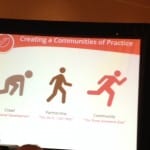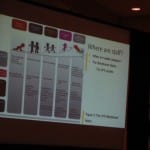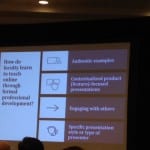This is the end of BbWorld15. My home has been the largest hotel, resort and convention centre I’ve ever seen. It’s a glass and steel bubble. For days I didn’t step outside. Apart from being too hot – in the mid thirties – you didn’t need to. Everything was on the inside including the trees and gardens although the glass lifts were not for the faint hearted! Also outside there wasn’t a great deal to see or do.
But on the inside it was was busy. Over 3000 delegates and dozens of parallel sessions, even going full pace you only scratch the surface. Already the conference is starting to blur but I have the key points loaded into these blog posts. They’re a bit rushed. Some of the pictures aren’t too good and not all of have alt text but they will be my reminder of the privilege of being here. Blackboard is one of the few conferences which crosses the boundaries and brings together this peculiar hybrid breed of academic developer, learning technologist and researcher. What unites us is the value we place on technology to make a difference to the student experience. What separates us is the work we do supporting the late adopters and digitally shy academics whilst promoting the need for inclusive practice so ensure no one gets shut out or left behind.
Adoption was a core feature of many presentations. There was a distinct shift in emphasis from what could be done to how to encourage and support engagement through sequential stepping.
I’ve got some new ideas. Maybe developing a rubric for universal design; capturing the core content of the four TELEDA learning blocks – learning design, open education, social media, working with audio and video – and releasing them as OER; continuing to find ways to apply the essential criteria of higher education – communication, critical thinking, deeper approaches to reflective practice – and applying them to technology training.
Underpinning it all is the affirmation I’ve received this week how core to all adoption just might be the shift from training to teaching – seeing e-teaching as the corollary to e-learning. While one of the messages of BbWorld is to put the student first, it’s increasingly clear how some people are starting to consider the changing attitudes towards digitally shy academics. Overall, attitudes to ‘faculty’ were not hugely sympathetic and this is part of the problem. If ever I needed evidence of the digital divides on campus between technologists and teachers there was plenty to choose from. Looking back over the years it’s difficult to find many attempts to rethink how digital support is provided and now we’re in a time where everyone is stretched and squeezed, the suggestion to invest more resources into digital staff development will not be popular. It needs more people to recognise and accept the adoption of digital technology is problematic. What troubles me is how those who promote, support and maintain it are often those who find it easy to use. They forget or have never experienced what it feels like to be digitally lost and confused.
The phone on the hotel room has a button called Consider it Done.
It’s linked to your room so you are greeted with your name and what comes across as a genuinely meaningful-sounding question ‘What can I assist you with today?’ Once I’d experienced this response I actually felt ok about using the service again. It made a difference to how I experienced not knowing something or not understanding how things worked. This is the effect we need to generate and make happen.









